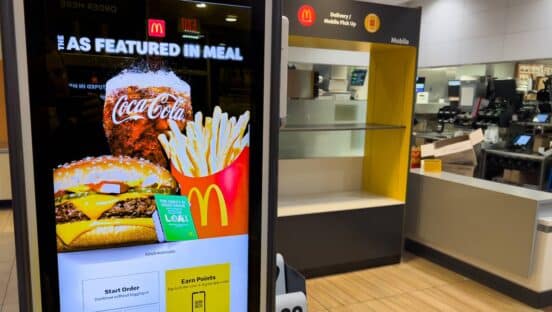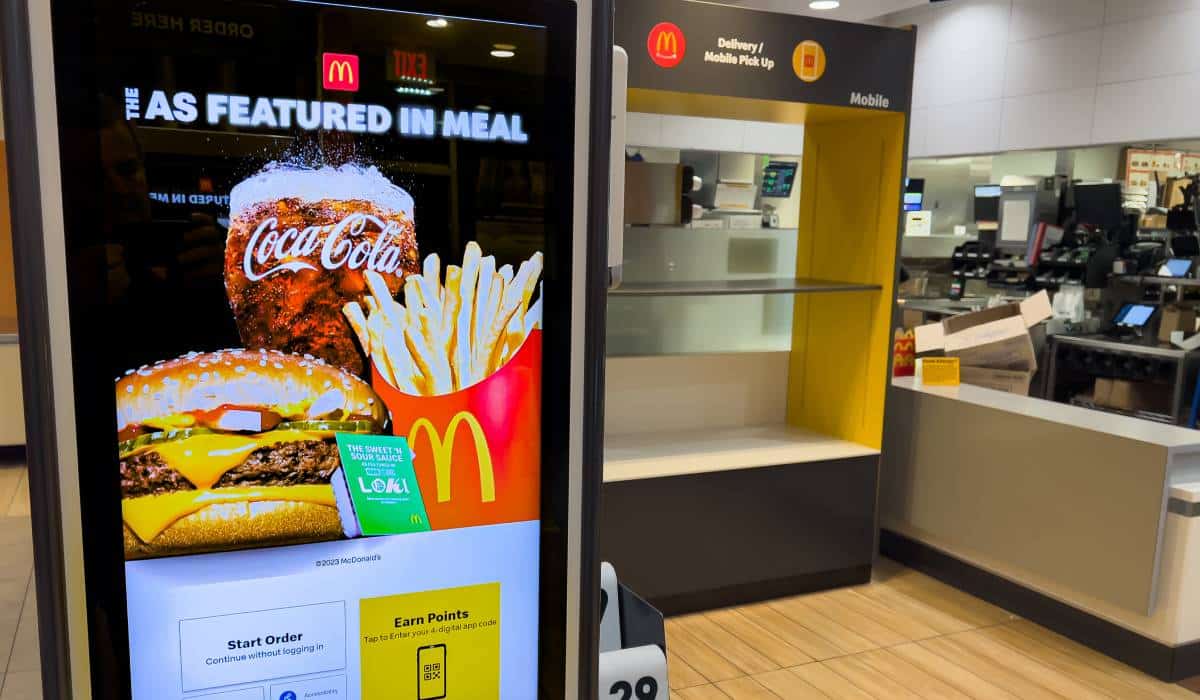McDonald’s last year reported net unit growth in the U.S. for the first time in eight calendars. The top earner in foodservice expanded by six stores to reach 13,444 domestic restaurants. CEO Chris Kempczinski told investors the plan for 2023 would be 4 percent global expansion or net growth of about 1,500 McDonald’s around the world. It wasn’t exactly clear how that broke down stateside, only that Kempczinski believed the chain’s recent performance “earned us the right to open new restaurants at a faster rate than we have historically.”
McDonald’s hasn’t slipped in 2023. U.S. same-store sales rose 8.1 percent in Q3, rolling over 6.1 percent growth in the year-ago period, thanks to menu price increases, marketing campaigns, and continued growth in digital and delivery. That after a 10.3 percent rise in Q2 and a 12.6 percent increase in Q1.
McDonald’s is about a week out (December 6) from hosting the company’s annual investor update and, theoretically, will provide a roadmap through some points. BTIG analyst Peter Saleh expects accelerated domestic development to be among them.
Through checks with franchisees, he said, it appears clear McDonald’s wants to ignite its pace of growth in the U.S. Saleh said he’s heard there are “upward of 250 new units” in the pipeline. Worth noting, this figure is likely a multi-year one. Still, Saleh added, contacts told BTIG McDonald’s was “very active” in purchasing property during COVID-19 to position itself for faster development with the proverbial dust cleared, with a particular focus on the South and Southeast regions given population trends.
On McDonald’s Q2 call, Kempczinski made a comment to support that notion, sharing the brand’s footprint “reflects what the population looked like probably 20 or 30 years ago.”
“So you end up finding there’s a number of places around the U.S. where we are significantly under developed relative to where the population exists today,” he said. “That opens up for us a whole bunch of development opportunities … to go after.”
A topic brewing within that sphere is whether the higher royalty rate McDonald’s unveiled in September would have an impact on unit openings. Saleh said franchisee opinions, from his conversations, have been mixed. Some felt it would stall expansion, as operators reassess their economic returns. Others said there was more than enough demand out there either way.
McDonald’s shift marked the first time it would raise royalty fees in three decades. It upped to 5 from 4 percent, which reportedly is set to take effect start of 2024. According to media outlets, the new rule won’t impact current operators maintaining their stores, those who buy a franchised restaurant from a fellow franchisee, rebuilt existing locations, or stores swapped between family members. It will reach new operators, those who purchase corporately owned units, and other situations. Additionally, McDonald’s plans to switch its terminology from “service fees” to “royalty fees.”
Joe Erlinger, McDonald’s USA president, said in a message to domestic franchisees the change was, among things, designed so U.S. and Canada were consistent with global markets. Currently, the brand uses a 5 percent royalty rate in all owned markets except for North America. According to Business Insider, McDonald’s first service fee (now royalty fee) was 1.9 percent in 1955. That rate grew five times in 30 years.
McDonald’s ended Q3 with 13,459 U.S. restaurants, including 12,700 franchised units and 689 corporate stores. Internationally there were 27,739 restaurants. The burger brand is the only chain in the world with more than 40,000 locations.
More holistically, Erlinger said McDonald’s was “trying to change the mindset by getting people to see and understand the power of what you buy into when you buy the McDonald’s brand, the McDonald’s system.”
The 100 basis-point royalty jump, Saleh said, will produce a limited financial impact given the small base of units it applies to (maybe a few hundred per year, or less than 2 percent of U.S. restaurants). But there are franchisees, he noted, who believe this is only one step toward raising the royalty figure for all operators. Saleh estimated the change will amount to a few basis points per year in the effective royalty rate, or $6 million to $7 million of incremental revenue, as you’ll see below, based on current unit openings and refranchising activity.

If McDonald’s were, in fact, to increase the royalty rate for all operators, the impact would leap to about 5 basis points per year, assuming a 20-year franchise agreement and evenly distributed expiration schedule, Saleh said. For now, though, the impact is minimal.
The more pressing development for investors, Saleh continued, appears to be much higher rent for new units. “We have heard from several franchisees that rent on new McDonald’s locations is in the mid- to upper-teens range, compared to the current system average of [about] 10 percent, combining for a 20 percent [of sales] income stream on new units,” he said.
Kempczinski said in Q3 franchise cash flow was up this year and increased during the period. “It’s much more challenging as you would imagine to continue to drive the business if the franchisees are not seeing it flow through,” Kempczinski said. “And fortunately for us, we’re seeing good flow-through for our franchisees despite having to absorb quite a bit of inflation, both on the food and paper side as well as on the labor side. So that’s another thing that gives us confidence as we head into the New Year.”
McDonald’s average price is a shade over 10 percent for the year. Executives said there’s been little customer deterioration and the brand still leads in affordability and value for money sentiments. Kempczinski also noted McDonald’s gained market share from middle- and higher-income households who have traded down from casual dining. Lower-income cohorts ($45,000 and under) have been sluggish during recent reports—a trend, Kempczinski said, surfacing across all of quick service. When looking at a two-year stack, he added, McDonald’s traffic is up significantly, despite dipping in Q3.
Finding ways to still bump the top-line despite tepid traffic growth is surely going to dominate much of next week’s update as well. Namely, the brand’s digital business mixed more than 40 percent of sales across McDonald’s top six markets last quarter, totaling nearly $9 billion. There are north of 57 million active rewards members in those trade areas.
If you go back a few years ago, McDonald’s grabbed headlines when it commented it had data on only about 5 percent of its customer base. Just the U.S. loyalty program alone now boasts more than 33 million people.
Saleh said he expects McDonald’s to share learnings, including visitation patterns, frequency across dayparts, etc., at the investor event. Put simply, the brand has data and insights into its customer base it never approached before. What does McDonald’s do with it?
Recent commentary suggested consumer frequency increased by 15 percent when guests join McDonald’s loyalty program. Saleh said franchisees he spoke to put the number closer to 2.5X.
In Q2, McDonald’s said sign-ups were still growing in the high-single digits and more than 52 million users were active in the past 90 days. McDonald’s U.S. business deployed an enhanced ordering process via the app to hasten experience. This growth led Kempczinski to share a “CosMc’s” prototype was in development that would be “a small format concept with all the DNA of McDonald’s, but its own unique personality.” The name comes from CosMc, an alien mascot that appeared in commercials during the 1980s and 1990s.
McDonald’s said earlier it would unveil more details on December 6. Some teasers have emerged on social media and the first location surfaced on Google Maps.
A TikToker, @snackolator, shared views from a construction site in Bolingbrook, Illinois. The big observation: four drive-thru lanes, akin to Taco Bell’s Defy (but not two levels).
@snackolator I have no idea what CosMc's will serve, but I'm very excited to find out what McDonald's has up their sleeve for this new concept. Are you excited for this new chain? What are you hoping they have? #mcdonalds #mcdonaldslife #mcds #cosmc #cosmcs #fastfood #mccafe #fastfoodlife #macdonalds #newfastfood ♬ original sound – snackolator
Last year, McDonald’s opened a small-format test restaurant in Forth Worth, Texas. The unit has an order-ahead drive-thru lane where customers receive orders via a food and beverage conveyor, and it’s equipped with technology that allows workers to prepare orders when guests get closer to the store. Additionally, there’s a delivery pickup room for couriers to retrieve orders, kiosks that accept cash and credit, and a pickup shelf. Outside, McDonald’s built several parking spaces dedicated to curbside order pickup alongside designated spots for delivery drivers.
Saleh predicts more innovation on deck, too. Over the past several years, he said, McDonald’s has developed and tested automated order taking technology in the drive-thru. It’s a topic that largely went quiet at McDonald’s and checks, Saleh said, indicated the effort stalled out and wasn’t being actively discussed. Yet recent conversations uncovered a renewed focus on the tech, with a 400–500-unit pilot in two markets happening in the near future, he said.
“This is a much larger population than previous tests, suggesting to us that the technology has been improved in some fashion and is closer to deployment,” Saleh said. “Our previous checks indicated that the order accuracy was in the low-to-mid-80 percent range, about 10 percent below the threshold McDonald’s would need to deploy.”
Even so, previous talks also noted automated ordering taking was rather expensive to implement and operate, he continued, generating only modest savings compared to traditional labor. Prior checks put the initial hardware cost at about $15,000–$20,000, with $25,000 per year in ongoing software expense. This compares with roughly $60,000 per year in annual labor costs to staff the drive-thru between 6 a.m. and 11 p.m. daily. “So while we believe franchisees will adopt this technology once it’s available and ready, we don’t believe there will be a significant cost benefit to those operators,” Saleh said.








